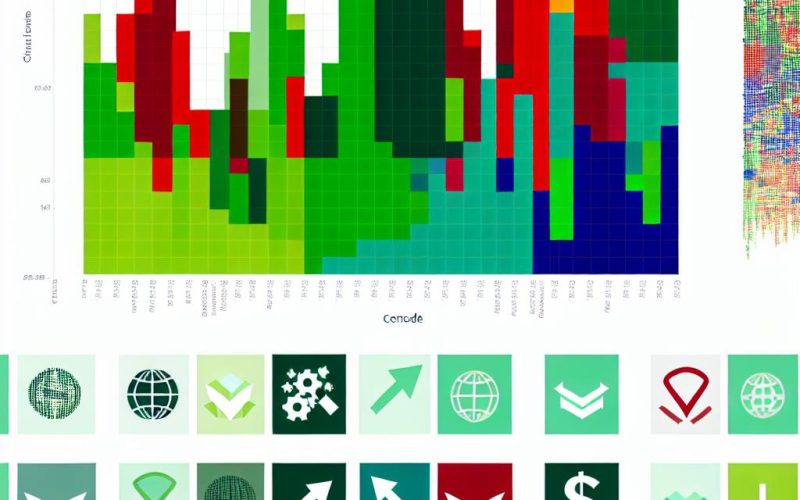Understanding Stock Market Heatmaps
Stock market heatmaps are a popular tool used by investors, whether they are novices or experienced traders, to effectively visualize market data. They provide a graphical representation of stock market information, where data is depicted in various colors and sizes to indicate different levels of price movement or volume. This visual format allows traders and analysts to quickly identify market trends and make informed decisions.
How Stock Market Heatmaps Work
At their core, stock market heatmaps illustrate data points such as stock prices, trading volumes, and general market performance using a range of colors and block sizes. Each block represents a specific stock or asset, with the size of the block usually indicating the market capitalization or trading volume.
Color Coding: Colors typically reflect stock performance. For instance, a green block often signifies an increase in price, while a red block indicates a decrease. The intensity of the color can provide a quick indication of the magnitude of the change.
Block Size: Block size might be used to signify the importance of a stock, often based on market capitalization. Larger blocks typically represent larger companies that have more significant impacts on index performance.
Interpreting Market Trends with Heatmaps
Stock market heatmaps can be instrumental in identifying market trends, sector rotations, and overall sentiment. By examining how colors and sizes are distributed across the heatmap, investors can gain insights into market dynamics.
Identifying Sector Trends
Heatmaps allow investors to discern which sectors are performing well and which are lagging. For instance, if a majority of green blocks are concentrated in the technology sector, this might suggest that technology stocks are experiencing a rally. Alternatively, widespread red in the healthcare sector could indicate systemic challenges or investor caution within that industry.
Sector Analysis
Investors often rely on heatmaps to perform sector analysis, aiding in decisions about sector allocations. By viewing sector-specific trends, they can adjust their portfolios by increasing investment in performing sectors or reducing exposure in those that are under-performing.
Spotting Market Movement
A market-wide increase in green blocks could signal a bullish trend, while a dominance of red might point to bearish sentiment. Such visualization can provide a quick check for overall market health, allowing investors to adapt their strategies accordingly.
Systematic Observation
Investors and traders develop an observational routine to systematically check the market sentiment by glancing at heatmaps. This systematic approach aids in monitoring market direction without the need for in-depth analysis of each stock individually.
Analyzing Volatility
By tracking the color intensity within a heatmap over time, investors can detect shifts in market volatility. Sharp changes in color distribution may indicate heightened market volatility, which can be crucial for risk management.
Risk Evaluation
Risk evaluation through heatmaps can be impactful when managing a portfolio. Investors often analyze color distributions and intensities to assess whether they need to deploy additional hedging tactics or risk reduction strategies.
Practical Applications of Heatmaps
Stock market heatmaps are accessible through various financial platforms and research tools. Traders can utilize these resources to promptly evaluate several key aspects of investment, such as identifying undervalued stocks or novel growth sectors that might not yet be evident through other analytical methods.
Investment Opportunities
Heatmaps can unveil potential investment opportunities by displaying price movements that may signify undervaluation. Investors strategically analyze these visual cues to identify stocks that could offer returns.
Sector Rotation Strategies
By observing which sectors are gaining momentum, traders can adapt their investment portfolios to capitalize on emerging trends. Conversely, sectors that are losing momentum can prompt investors to consider reallocating their resources.
Risk Assessment
Understanding broader market sentiment is a key consideration for any investor. Through heatmap analysis, market sentiment can be gauged, and exposure adjusted according to perceived market risks.
Portfolio Adjustments
Frequently, traders make portfolio adjustments based on the overarching sentiment gleaned from heatmaps. Such adjustments involve realigning assets to protect against downturns or to capture growth opportunities.
Accessing Stock Market Heatmaps
Multiple financial services offer heatmaps integrated with detailed market analytics. These tools are prevalent on platforms ranging from financial news websites to dedicated investment services, providing users with varying features tailored to specific investment needs. By exploring different platforms, investors can find the heatmap tools that align with their investment style and objectives.
Choosing the Right Platform
Ensuring the choice of a suitable platform involves examining the suite of tools offered. Some platforms provide basic heatmap functionalities, while others integrate sophisticated analytics for in-depth market research.
Suitability and Features
Investors assess the range of features and data included, such as real-time updates, customizability, and integration with existing analytics. Evaluating these factors ensures that the chosen heatmap tool aligns with specific investment strategies and goals.
Conclusion
Stock market heatmaps serve as an invaluable instrument for investors aiming to visualize and evaluate market data succinctly. By understanding and leveraging the various aspects of heatmaps—such as color coding and block sizing—an investor can draw significant insights into market behavior, ultimately leading to more informed and strategic decision-making. As technology continues to improve, these tools will undoubtedly become more prevalent, providing investors with even richer datasets and nuanced visual analyses of the markets.
This article was last updated on: July 7, 2025

